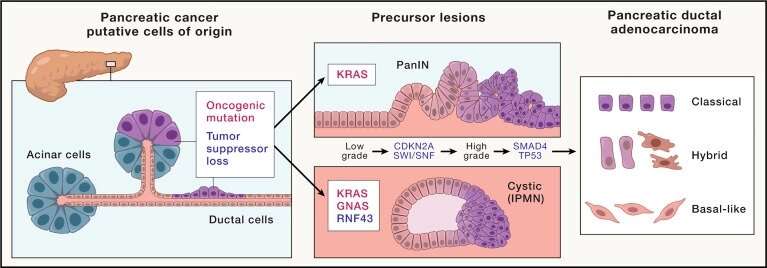This article has been reviewed according to Science X's editorial process and policies. Editors have highlighted the following attributes while ensuring the content's credibility:
fact-checked
peer-reviewed publication
trusted source
proofread
Researchers identify hallmarks to improving pancreatic cancer therapy

Scientists from the University of California, Irvine, the University of Michigan and the University of Texas MD Anderson Cancer Center have made a significant contribution to the field of pancreatic cancer research. Their new study presents several crucial themes in the biology of pancreatic cancer that can serve as hallmarks for pancreatic cancer therapy. These themes include genomic alterations, metabolism, the tumor microenvironment, immunotherapy and innovative clinical trial design. The study appears in the journal Cell.
Pancreatic ductal adenocarcinoma, which represents the vast majority of pancreatic cancers, is one of the most challenging and fatal forms of cancer. Despite the substantial progress made in understanding the biology of PDAC over the past few decades, clinical care for most patients has not seen a major breakthrough. However, the authors believe that combined progress in these areas they have defined as hallmarks will prove transformative to the treatment of this disease.
According to Christopher Halbrook, assistant professor of molecular biology & biochemistry at UCI and lead author, "Initial efforts to target PDAC vastly oversimplified the complexity of the disease. It has taken several decades of hard work during which we have been aided by technological breakthroughs in techniques to understand intricacies of pancreatic tumors to finally provide us with a roadmap for the development of better treatments for our patients."
The authors emphasize the importance of approaching the disease from multiple angles, encompassing as many of the hallmarks as possible for the highest chance of success.
Their review summarizes the consensus models that have emerged underpinning the genetic development and path-wise progression of pancreatic tumorigenesis. It further highlights several exciting examples of ongoing research, including the development of investigational compounds and clinically deployed approaches to target the genetic and immunological features of PDAC, cancer metabolism and chemoresistance.
The authors also discuss how advances in single-cell analysis and high-dimensional spatial profiling techniques have revealed the diversity of cell populations dynamically interacting within pancreatic tumors and discuss how to begin disrupting these networks to improve response to treatment. These approaches will pair with exciting avenues of new therapeutic development, such as cancer vaccines and antibody-drug conjugates, which hold enormous potential for the future of pancreatic cancer therapy.
The authors also express their optimism about the future of pancreatic cancer research and treatment.
"The previous 10 years has already seen the 5-year survival rate of PDAC double after remaining stagnant for decades prior. We are confident that the collective efforts of the scientific community will continue this trend to transform PDAC from a recalcitrant disease to a manageable disease," said Halbrook.
The authors hope that their findings will inspire further research and ultimately lead to improved treatments and outcomes for pancreatic cancer patients.
The work involved collaboration with Costas Lyssiotis and Marina Pasca di Magliano from the University of Michigan, and Anirban Maitra from the University of Texas MD Anderson Cancer Center.
More information: Christopher J. Halbrook et al, Pancreatic cancer: Advances and challenges, Cell (2023). DOI: 10.1016/j.cell.2023.02.014



















